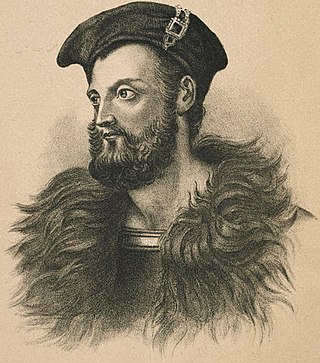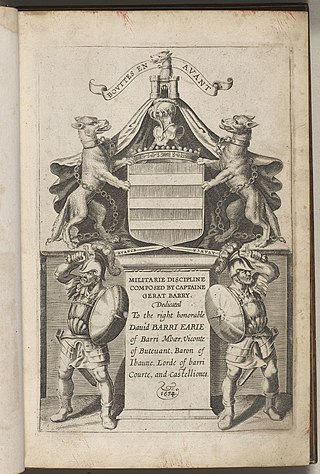Related Research Articles

Owen Roe O'Neill was a Gaelic Irish soldier and one of the most famous of the O'Neill dynasty of Ulster. O'Neill left Ireland at a young age and spent most of his life as a mercenary in the Spanish Army serving against the Dutch in Flanders during the Eighty Years' War. After the Irish Rebellion of 1641, O'Neill returned and took command of the Irish Confederate Ulster Army. He is known for his victory at the Battle of Benburb in 1646.
Thomas Preston, 1st Viscount Tara was an Irish soldier of the 17th century. After lengthy service as a mercenary in the Spanish Army, Preston returned to Ireland following the outbreak of the Rebellion of 1641. He was appointed to command the Leinster Army of the Irish Confederacy, enjoying some success as well as a number of heavy defeats such as the Battle of Dungans Hill in 1647 where his army was largely destroyed. Like other Confederate leaders, Preston was a Catholic Royalist. He remained in close contact with the Lord Lieutenant the Marquess of Ormonde, and was a strong supporter of an alliance between Confederates and Royalists against the English Republicans.

The Irish Confederate Wars, also called the Eleven Years' War, took place in Ireland between 1641 and 1653. It was the Irish theatre of the Wars of the Three Kingdoms, a series of civil wars in the kingdoms of Ireland, England and Scotland – all ruled by Charles I. The conflict had political, religious and ethnic aspects and was fought over governance, land ownership, religious freedom and religious discrimination. The main issues were whether Irish Catholics or British Protestants held most political power and owned most of the land, and whether Ireland would be a self-governing kingdom under Charles I or subordinate to the parliament in England. It was the most destructive conflict in Irish history and caused 200,000–600,000 deaths from fighting as well as war-related famine and disease.

Sir Phelim Roe O'Neill of Kinard was an Irish politician and soldier who started the Irish rebellion in Ulster on 23 October 1641. He joined the Irish Catholic Confederation in 1642 and fought in the Wars of the Three Kingdoms under his cousin, Owen Roe O'Neill, in the Confederate Ulster Army. After the Cromwellian conquest of Ireland O’Neill went into hiding but was captured, tried and executed in 1653.

Confederate Ireland, also referred to as the Irish Catholic Confederation, was a period of Irish Catholic self-government between 1642 and 1652, during the Eleven Years' War. Formed by Catholic aristocrats, landed gentry, clergy and military leaders after the Irish Rebellion of 1641, the Confederates controlled up to two-thirds of Ireland from their base in Kilkenny; hence it is sometimes called the "Confederation of Kilkenny".

The Battle of Benburb took place on 5 June 1646 during the Irish Confederate Wars, the Irish theatre of the Wars of the Three Kingdoms. It was fought between the Irish Confederates under Owen Roe O'Neill, and an army of Scottish Covenanters and Scottish/English settlers under Robert Monro. The battle ended in a decisive victory for the Irish Confederates and ended Scottish hopes of conquering Ireland and imposing their own religious settlement there.
Hugh Dubh O'Neill, 5th Earl of Tyrone (1611–1660) was an Irish soldier of the 17th century. He is best known for his participation in the Irish Confederate Wars and in particular his defence of Clonmel in 1650.

The Battle of Scarrifholis, also spelt Scariffhollis was fought on 21 June 1650, near Letterkenny in County Donegal during the Cromwellian conquest of Ireland. A force loyal to the Commonwealth of England commanded by Charles Coote defeated the Catholic Ulster Army, commanded by Heber MacMahon, Roman Catholic Bishop of Clogher.

Ó Fearghail is a family name of the Irish nobility from County Longford who were historically the Princes of Annaly. The patronym means "descendant of Fearghail", whose name means "man of valour". Fearghail was a great-grandson of Angaile, the 10th-century King of Fortúatha who conquered and gave his name to Annaly, and his Ó Fearghail descendants were the Princes of Annaly for 6 centuries. Angaile was chief of the Conmhaícne Angaile. The lineage of Fearghail produced chiefs of the Dál Messin Corb and the Uí Garrchon. English forms of the surname include O'Farrell, O'Ferrall, Ferrell and Farrell.

Garret Barry, also called Gerat, was an Irish soldier and military writer, who fought for Spain in the Eighty Years' War and then for the Irish insurgents in the Rebellion and the Confederate Wars. When young he left Kinsale at its surrender in 1602 for Spain where he took service, first as marine in the Atlantic Fleet and then in the Army of Flanders. While in Spanish service, he fought at the Siege of Breda in 1624/1625. He retired with the rank of captain in 1632. Returning to Ireland he was at the Rebellion appointed general of the insurgents' Munster Army. He took Limerick in June 1642 but was defeated at Liscarroll by Inchiquin in September. He was confirmed as General of the Munster Army by the Irish Catholic Confederation but was in practice superseded by Castlehaven in 1643.

The city of Waterford in southeastern Ireland was besieged twice during 1649 and 1650 during the Cromwellian conquest of Ireland. The town was held by Irish Confederate Catholic under General Richard Farrell and English Royalist troops under general Thomas Preston. It was besieged by English Parliamentarians under Oliver Cromwell, Michael Jones and Henry Ireton.
The siege of Charlemont took place in July – 14 August 1650 during the Cromwellian conquest of Ireland when the fortress of Charlemont in County Armagh Ireland was besieged by Charles Coote's Parliamentarian army, which was largely composed of soldiers of the New Model Army. The force led by Coote eventually took the fort from its Irish defenders, but not before they suffered heavy losses, with some 500 Parliamentarian Soldiers being killed during assaults on the formidable stronghold. In terms of the number of soldiers killed in battle, the siege of Charlemont was the second bloodiest engagement fought by the Parliamentarians in Ireland, only surpassed by the siege of Clonmel.
Presented below is a chronology of the major events of the Irish Confederate Wars from 1641 to 1653. This conflict is also known as the Eleven Years War. The conflict began with the Irish Rebellion of 1641 and ended with the Cromwellian conquest of Ireland (1649–53).
Colonel Gordon O'Neill, was an officer in King James II's Irish army who fought at the Siege of Derry, the Battle of the Boyne, and the Battle of Aughrim for the Jacobites.
The Battle of Portlester took place on 7 August 1643 near the town of Ballivor, Leinster in Ireland as part of the Irish Confederate Wars. It was fought between Irish Confederates under Owen Roe O'Neill and a Protestant Royalist force from Dublin under Lord Moore. The battle consisted primarily of an exchange of artillery fire in which Moore was killed and his army driven off, giving the Confederates victory.
Rosa O'Neill was a member of the Ó Dochartaigh noble family of Inishowen in County Donegal who lived during the late Tudor and Stuart eras.

"The Lament for Owen Roe" is a traditional Irish ballad dating from the nineteenth century. With a mournful tune, based on an eighteenth-century composition called Lament for Owen Roe O'Neill by the harpist Turlough O'Carolan, it is a lament for the death of Owen Roe O'Neill. Its lyrics were written by Thomas Davis and draw on the tradition of romantic nationalism which was at its height during the era.
The siege of Dublin took place in 1649 during the Irish Confederate Wars. It was a failed attempt by combined Irish Royalist and Confederate forces to capture the capital of Dublin which was held by English Republican forces under Michael Jones. It was part of a strategy by Duke of Ormonde, head of an alliance loyal to Charles II, to seize the remaining foothold of Ireland still under the control of the London Parliament.

The Laggan Army, sometimes referred to as the Lagan Army, was a militia formed by Protestant settlers in the fertile Laggan district in the east of County Donegal in Ulster, during the time of the Irish Rebellion of 1641.

The Second Ormonde Peace was a peace treaty and alliance signed on 17 January 1649 between the Marquess of Ormonde, the leader of the Irish Royalists, and the Irish Confederates. It united a coalition of former Protestants and Catholics enemies from Ireland, Scotland and England – the three Kingdoms ruled by Charles I who was then held a prisoner by the Puritan Rump Parliament. His execution on 30 January drew together the signatories in allegiance to his young son Charles II.